More actions
| Dragonkin | |
|---|---|
 | |
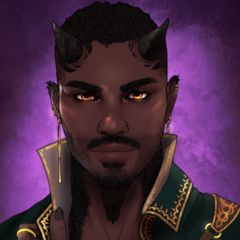 | |
| Nation State | N/A |
| Ruler | N/A |
| Other Present | N/A |
| Languages | Varied |
| Religion | Draconism |
| First Recorded | 20,000 BC |
| Demonym(s) | Dragonkin |
Dragonkin, often also called Velkaryn, are a grouping of societies comprising humanoids who descend from the lesser Dragons. The arrival of Dragonkin was once meant to herald the age of mortals and exist like a fading memory of the Dragons that once roamed the world, becoming ever more distant from their ancient ancestors. With the return of the Dragons, however, Dragonkin have been thrust to the foreground of global events taking an important role in the Draconism faith, and geo politics, chiefly led by the Songaskian Dragonkin.
Design
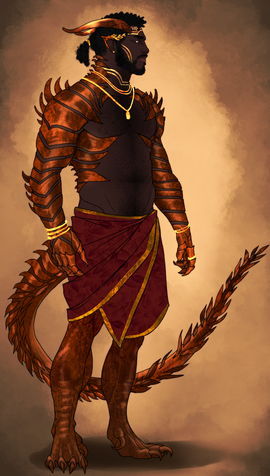 |
Dragonkin are not truly a Heritage or ethnicity in the same way as an Ailor, Dwarf, or Lanlath Elf might be. In fact, Dragonkin can be any of these Heritages, because what defines them is how their soul is made rather than their biology. Dragons are the stewards of the soul cycle in the world that dictates how new life is created. Dragonkin are not born from reproduction by Dragons as often assumed. When a Dragon dies in a very specific way called a Dragonfall, their soul erupts into tens of thousands of Dragonsparks, each of which creates a new soul and life. It has been hundreds of years since the last Dragon died, though rather than die out, Dragonkin continue to sire more Dragonkin as they reproduce as nurture and seed new Dragonsparks. Because of this, Dragonkin are biologically as if they belong to a different Heritage. The Dragonspark however, changes them. As seen in the image, Dragonkin are partly or wholly covered in Dragonscales. Dragonkin can reduce or increase the amount of scales present on their body. Dragonkin also have horns and a draconic tail, as well as clawed feet and hands. Just like the scales on their body however, these can be hidden, though no matter how much a Dragonkin hides some scales cannot be fully hidden to hide their identity. Any Heritage can have Dragonkin appear from them, though Ailor is the most common, as they were geographically located where the most Dragonfall events occurred. When understanding what a Dragonkin would look like, refer to their pages, and superimpose Dragon traits. Choosing a biological appearance is important when making a Dragonkin Character, and special attention will be given to this in the Heritage Traits section further down. Dragonskin can also forsake any skin, fur, or hair they might have, and become fully covered in scales. This transformation is completed, by having their more humanoid head change to that of a lizard-like dragon head complete with horns, scales, and slitted eyes. This type of appearance is called a Dragonkin's Drakemask. Dragonkin may have elf-like pointed ears with scales on them or no scales. And finally, Dragonkin tend to be more physically imposing than their non-Dragonkin counterparts. A Dragonkin Ailor for example is easily a foot taller than the average Ailor might be. The only Draconic trait Dragonkin do not have, are Draconic wings. What color a Dragonkin's scales appear as, as well as their eye color is strongly dictated by the Dragonfall they descend from, as each Dragon has a very specific appearance. Each Dragonfall and traits are mentioned below.
|
Heritage Traits
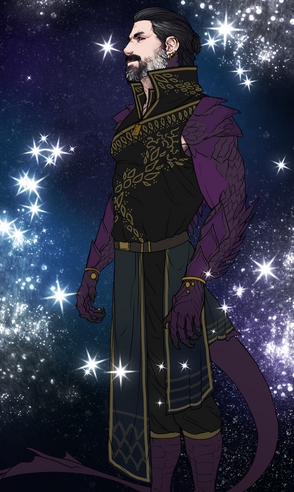
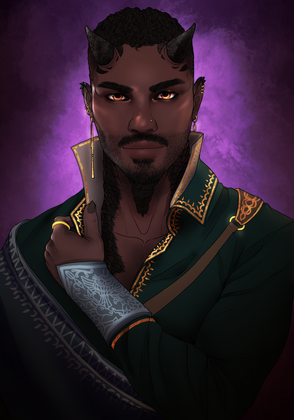
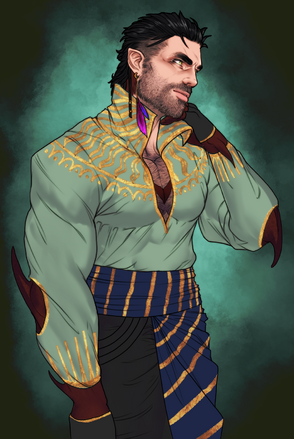
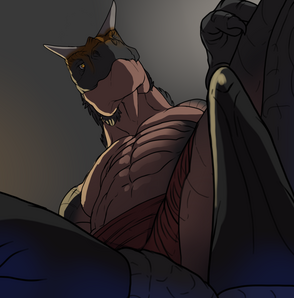
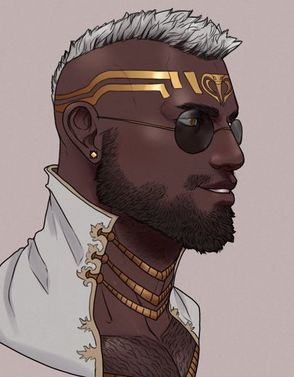
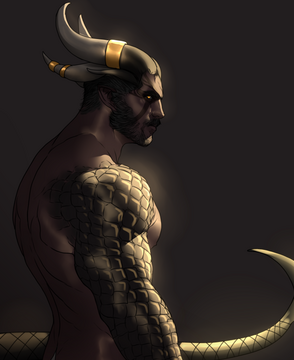
In Character Design, Proficiency allows for the buying of Packs, which give Combat Abilities. Heritage Traits add free Packs and Mechanics to a Character, fit around cultural themes. Mechanics are flair and roleplay opportunities Characters have outside of Combat, while Packs are Combat Power. Free Magic Packs can always be defined as any Alignment. Mixed Heritage Characters (characters of two different culture parents) choose one set of Free Packs, and can mix and match Mechanics from both parents up to a maximum of 5 Mechanics. There is no such thing as a Half-Dragonkin (but Mixed-Heritage can be Dragonkin).
Free Packs
- Dragonkin gain the Magical variant of Safeguard Pack for free, or choose one pack from Prayer Point Buy.
- Dragonkin gain the Steady Body Pack for free, or choose one Pack from Cleric Point Buy.
Mechanics
- Dragonkin inherits the Mechanics from the Heritage Trait from whatever Heritage the Character is biologically made. For example, if you want to play an Ailor Dragonkin, you can take the Mechanics from the Ailor Heritage as seen on their page. There are some exceptions: Slizzar, Bralona, Mystech, and Maraya awoken from a Vault cannot be Dragonkin. Urlan can only be Dragonkin if they were Dragonkin before Urlan.
- Dragonkin can control elements that are closely associated with their Dragonfall. Dijara Dragonkin can control sand and sunlight. Dramarys Dragonkin can control snow/ice and starlight. Aerun Dragonfall can control silver/gold and crystals. Velkaryn Dragonfall can control shadows/darkness and the wind. Control can be defined as moving around, shaping into objects, summoning, extinguishing/radiating, and more.
- Dragonkin are closely aligned to Dragon Magic. Being made of pure life, they live extended lifespans beyond what is normal. The Immortal War has hardened Dragonkin against Mystech, causing them to take -1 HP Damage (instead of -2 HP) from Attack Emotes. However, they are threatened by beings of pure death. If a Character that has Ordial Alignment would do -2 HP Damage, they do -3 HP Damage instead.
Language and Naming
There is not truly a unified society of Dragonkin in the world, save for the Songaskian Masaya (comprised mostly of Dijara Dragonkin) and the Life Isldar Holds (which only have a minority of Dramarys Dragonfall). As such, there is no truly unified naming custom among the Dragonkin that is used, and their naming styles may vary strongly depending where they were born and what language they primarily speak. In the Songaskian Dragonkin use the Sofa language (based on real-world Bambara, spoken in Mali). When seeking to use name generators, avoid Islamic names, which are common in modern-day Mali. For Isldar, refer to their page.
Dragonheart Naming
Even though Dragons, Dragonkin, and Archon don't have a formal draconic language unifying them, Dragons and Dragonkin alike do have a metaphorical Dragonheart name. A Dragonheart name is a chosen and deeply personal name that says something about the ambitions, skills, and history of a Dragonkin. Usually, such names are epithets, like The Wandering Gold-Eye (for a Dragonkin who travels a lot), or Death-Singing Silver Blade (for a Dragonkin who is skilled with the sword, and fights with silvery weapons). Dragonheart names are chosen when a Dragonkin becomes an adult, and is rarely revealed except to those closest to them.
Conflicts and Alliances
Religions
By far and large, Dragonkin are Draconism worshipers. It is very hard to distance Dragonkin from being related through some distant lineage to actual Gods, and to reject that religion in favor of another. However, for nearly 300 years, the Dragons were gone, and Draconism was left in a state of ignorance due to the disappearance of their Gods. It is possible to play a Dragonkin who is not a Draconist by birth.
- Draconism: is the most obvious Religion for the majority of the Dragonkin, which acknowledges their descent as closely related to Dragons, but not divine.
- Unionism: There is a decently sized minority of Unionist worshipers among the Dragonkin, due to the presence of Dragonkin and Dragons within the Pantheon.
- Estelley: Especially Aerun Dragonkin are likely to be Estelley worshipers, because Draconism was eradicated in the Elven lands after their flight to Ellador.
- Fornoss: Dragonkin are rarely seen among Fornoss worshipers, though small pockets of them exist in Ellador that were colonized by early Velheim Ailor.
- Evolism: Evolism has very little to offer for Dragonkin, despite the presence of a Dragon in their Pantheon. Evolists see Dragonkin as enemies.
- Baskarr: Baskarr is mostly an Asha ethnoreligion, and because there are extremely few Asha Dragonkin, there are even fewer Dragonkin who worship Baskarr.
Brief History
Songaskian History
Velkaryn History
Wyrmborn History
Aerunthar History
Cultures
Fashion
Expanded Lore
Expanded Lore exists to apply more content and deep-lore exploration. This section is optional reading that is not needed for a good experience, though if you play a Scholar of a kind, reading this is encouraged.
The nature of Dragonfalls
A Dragonfall is a somewhat mysterious event that is not well understood, even among Dragons and Dragonkin themselves. Dragons are functionally immortal, even after the Immortal War and through the Denial of Immortality, their presence on the world could not be fully banished. A Dragon's soul is eternal even if their body is not conscious, in the same sense as other Gods are eternal but not always powerful. Not all Dragons experience Dragonfall, and not all Dragons are Gods. Within the frame of Draconism, the major Throne leading Dragons are Gods, but their lesser Dragons are not. They are considered divine within the religion, but do not seem to be necessary for the functioning of the world, they just make the work of the leading Dragons easier by dividing tasks. Dragonfall can only occur with these lesser Dragons, as Dragon God souls cannot seem to be split apart and can only be re-incarnated whole. Additionally, a Dragonfall can only occur when the lesser Dragons "die" at the same time as the Dragon God.
Historically, such events have only occurred in very specific circumstances, two of which are recorded in the current cycle of civilizations, while the two others are lost to time. All Dragonfalls follow the same sequence of events: a Dragon God is pushed to their utter limit of tolerance to conflict (being hunted, being attacked over and over, being pushed into a corner and losing a struggle), during which doubt and anxiety set in. During such a time, foreign entities can interfere with a Dragon God's sound mind, such as for example the Arch-Void Demon or the Death God the Malefica. In such an instance, these hostile entities hijack a fraction of a Dragon God's power to cause an immense death-event, which causes 100,000+ deaths in a near-instant, with some having been recorded as counting into dozens of millions. Then, the Dragon God "dies" (or at least, perishes from active consciousness), after which the other lesser Dragons perish in turn. These lesser Dragon souls then erupt into the Soul Rivers, into tens of thousands of fragments, which then seed new souls and create Dragonkin.
Historically, this has resulted in the instantaneous appearance of fully grown and taught adult Dragonkin through magical nascence, such as for example the appearance of millions of Songaskian Dragonkin after the Great Storm that killed both the Bronze Etherforge Dragons and the Sariyd Empire. While these instant appearances of Dragonkin usually happen geographically close to where the Dragons have died (usually within a few hundred miles), the Dragonkin afterward spread across the world as their mortal travels take them far and wide, thus spreading the Dragonspark. Any Dragonkin that sires new offspring creates more Dragonkin, as part of their Dragonspark is transferred to their children. This is why even though all Dijara Songaskians originally were Ailor biologically and had dark skin, in the present era, those born in colder climates for example Asha or Kathar might also be Dijara Dragonfall, if they had a Songaskian Dragonkin ancestor several centuries back that traveled there. Dragons rarely if ever speak of Dragonfall, largely because they have a vested interest in ensuring their enemies do not know how to kill them, though it is safe to say that even they do not understand how they work, as Dragons were not the original creators of life and death.
Nature within Draconism
It is easy to mistake Dragonkin as Godborn to Draconism faithful as these demigods of other religions might be to their flock. Dragonkin are not considered divine or even divinely touched by the Draconism faithful, however, even if they are technically a few jumps away from being related to the Dragon Gods. This is because the fragmentation of a Dragon's soul is so large that the tiniest of fragments that are used to seed the soul of a Dragonkin could not possibly contain any kind of divine power. That being said, due to their proximity visually to Dragons, and their relative rarity outside of Songaskian and Isldar society, they may sometimes be mistaken by more simple country folk as divine messengers or even Dragons themselves. There have been Dragonkin who have abused this perspective, an occurrence that is especially more common among the Songaskian Dragonkin, as they believe themselves to be the heirs to power vacuum left by the crumbling of the Sariyd Empire. In the end, how Dragonkin are seen religiously, is up to the individual worshiper, but by canon law, they are considered less divine/holy than Daiana Dragonborn, and even they are sometimes just seen as tools to the faith.
Trivia
- Slizzar cannot become Dragonkin due to a specialized process of creation Nox used. They can however use their shapeshifting abilities to mimic the appearance of a Dragonkin. Nearly all Dragonkin find this deeply offensive, and extend that disdain to any shapeshifter besides a Slizzar who might appropriate their Draconic heritage.
- Dragonkin souls cannot be offered up to Ordial Entities, meaning that the Beyond is devoid of any Songaskian Dragonkin, for example. This greatly annoys the Death Gods, who think they own Dragonkin due to their creation in their plots.
- Dragonkin are often called Velkaryn, despite this name describing only one type of Dragonfall Dragonkin. This is because Regalia's linguistic terms are often just defined by whatever first thing was experienced in the concept they are trying to define. Because Velkaryn Dragonkin appeared in Anglia before the Regalians had contact with any other type of Dragonkin, the term used to define these Anglian Dragonkin became a term used for all of them.